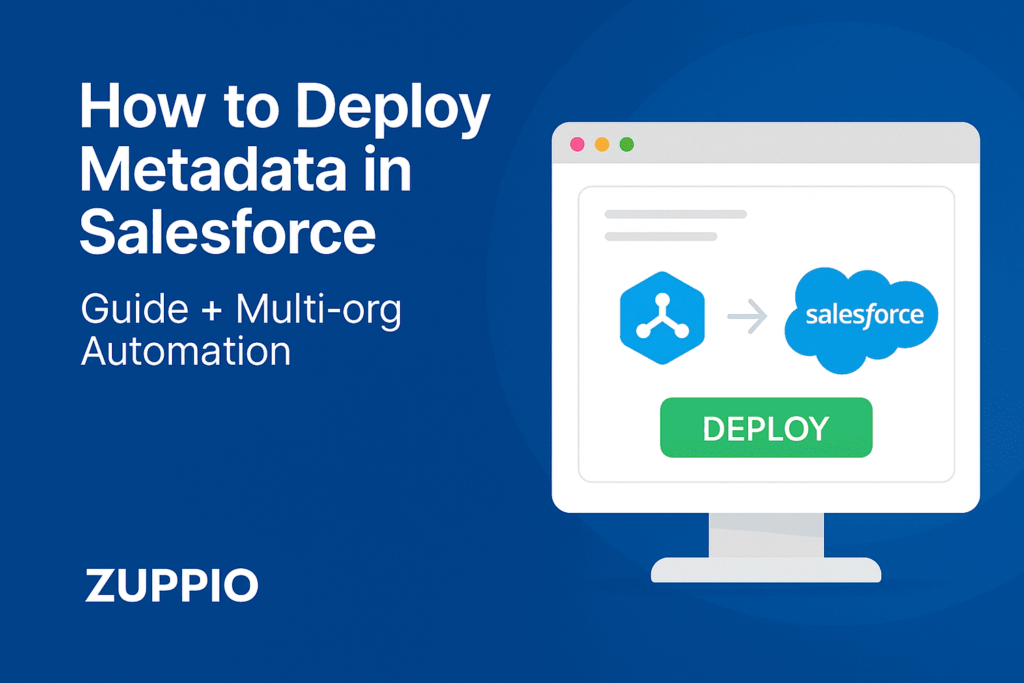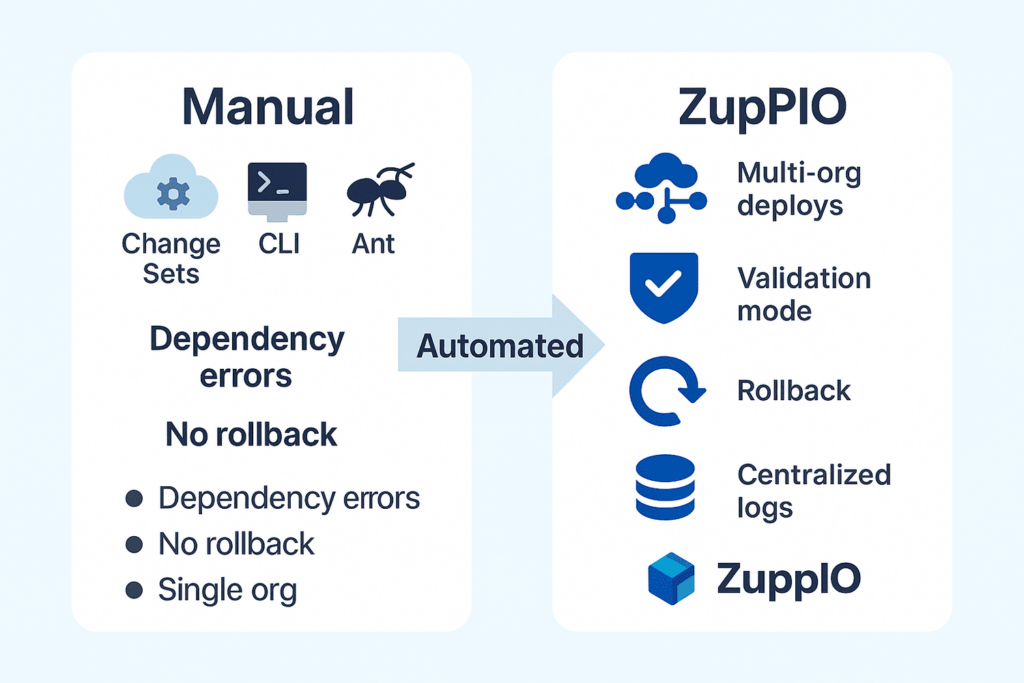How to Deploy Metadata in Salesforce?
To deploy metadata in Salesforce, you can use Change Sets, Ant Migration Tool, or Salesforce CLI (SFDX). Change Sets are easiest for admins, while Ant and SFDX give developers more control. Deployment usually involves selecting components, packaging them, and pushing to a target org. For ISVs and enterprises, ZuppIO simplifies this with multi-org deployments, validation mode, rollback strategies, and centralized logs.

What Is Metadata in Salesforce?
In Salesforce, metadata represents the configuration of your org — not the business data itself, but the blueprints that define how the org works. Metadata includes objects, fields, page layouts, record types, validation rules, workflows, and even Lightning components.
Understanding this distinction is crucial. Data refers to records stored in your org — accounts, contacts, opportunities. Metadata defines how those records are structured and how users interact with them. For example, adding a new custom field is a metadata change, while filling that field with values is data entry.
Managing metadata is a core responsibility of Salesforce teams. Every deployment, whether it’s a small update to a validation rule or a new managed package version, involves metadata changes. Because these changes directly affect user experience and business processes, their deployment must be done carefully and consistently across all environments.
Standard Ways to Deploy Metadata in Salesforce
Salesforce offers multiple methods to deploy metadata, each suited for different skill levels and project requirements.
Change Sets
- Native Salesforce feature.
- Works only between related orgs (e.g., Sandbox → Production).
- Admin-friendly but limited for complex deployments.
- Steps: create an outbound Change Set, select components, upload to target org, deploy.
- Limitations: no rollback, no version control, manual component selection.
Ant Migration Tool
- Command-line utility based on the Salesforce Metadata API.
- Uses
package.xmlto define components. - Flexible for complex deployments and CI/CD pipelines.
- Requires technical expertise.
- Advantages: automation, repeatability.
- Limitations: steeper learning curve, XML management overhead.
Salesforce CLI (SFDX)
- Modern tool for developers.
- Commands like
sfdx force:source:deployandsfdx force:source:retrieve. - Works seamlessly with Git version control.
- Supports scratch orgs for agile development.
- Ideal for DevOps teams building CI/CD pipelines.
Each of these approaches works, but all share limitations: they are scoped to single-org deployments and require significant manual intervention or scripting.
Common Challenges in Metadata Deployment
Despite the tools available, metadata deployments in Salesforce are rarely straightforward. Teams often encounter:
- Dependency errors: deploying a field without its parent object, or missing related components.
- Partial deployments: forgetting to include layouts, validation rules, or workflows.
- No rollback option: if a deployment fails, there’s no native way to revert to a previous state.
- Distributed logs: troubleshooting issues requires combing through logs in multiple places.
- Scalability issues: for ISVs or large enterprises, managing deployments across dozens or hundreds of orgs is time-consuming and error-prone.
These challenges grow exponentially as the number of orgs increases. A process that works for one Sandbox → Production flow may not scale for an ISV managing 100+ subscriber orgs.
Why Manual Deployments Are Not Enough for ISVs and Enterprises
For a single admin, deploying metadata via Change Sets might be manageable. But manual deployments break down at scale.
- ISVs face the challenge of updating hundreds of customer orgs whenever a package is upgraded. Subscriber-editable components (like page layouts or picklists) aren’t automatically updated, creating inconsistency.
- Enterprises must coordinate changes across multiple sandboxes, staging environments, and production orgs. Manual processes increase the risk of errors, delays, and compliance issues.
- No rollback means that a failed deployment can disrupt users for hours until fixes are manually applied.
In this context, automation becomes not just convenient but essential. Enterprises and ISVs need tools that provide multi-org deployments, validation before execution, centralized logging, and rollback strategies.
Automating Metadata Deployments with ZuppIO

ZuppIO is designed to solve these scale challenges. Instead of managing deployments one org at a time, it enables admins, developers, and ISVs to:
- Deploy metadata across multiple orgs simultaneously using mass ZIP deploys.
- Validate deployments before execution to catch dependency issues early.
- Roll back changes if errors occur, ensuring business continuity.
- Centralize logs and audit trails for compliance and troubleshooting.
- Integrate with GitHub and Bitbucket for CI/CD pipelines, triggering deployments automatically after commits or merges.
Example scenario: An ISV releases a new managed package version. Subscriber-editable components like page layouts aren’t updated automatically. Instead of manually fixing each org, the ISV uses ZuppIO to push consistent layouts, permission sets, and post-deploy Apex scripts across all subscriber orgs in one Job.
With features like metadata management, multi-org deployment, validation mode, rollback strategy, and CI/CD integration, ZuppIO goes beyond Salesforce’s native tools to provide a robust enterprise-grade deployment solution.
Best Practices for Metadata Deployment
Whether you use Change Sets, CLI, or ZuppIO, following best practices ensures smoother deployments:
- Always test in a Sandbox before Production.
- Use package.xml or source-tracked projects to control what’s deployed.
- Perform validation-only deployments to confirm changes before execution.
- Maintain centralized logs to track every deployment.
- Automate as much as possible with CI/CD pipelines.
- For ISVs, rely on tools like ZuppIO for multi-org consistency and risk reduction.
By combining Salesforce-native tools with best-in-class automation like ZuppIO, teams can reduce downtime, avoid manual errors, and release updates more efficiently.
Conclusion
Deploying metadata in Salesforce can be done with Change Sets, Ant, or Salesforce CLI. These methods work for individual orgs, but they don’t scale well for ISVs or enterprises.
ZuppIO extends deployment capabilities by enabling mass ZIP deploys, validation, rollback, centralized logging, and CI/CD integration. This ensures deployments are consistent, reliable, and efficient across multiple environments.
For admins, developers, and DevOps teams, ZuppIO turns metadata deployment from a risky manual process into a controlled, automated workflow.
What is metadata in Salesforce?
Metadata in Salesforce refers to the configuration and structure of your org, not the business records themselves. Examples include custom objects, fields, page layouts, validation rules, workflows, Lightning components, and permission sets. Metadata defines how data is stored and how users interact with it. In contrast, data refers to actual records like accounts or contacts.
How do I deploy metadata from Sandbox to Production?
To deploy metadata from Sandbox to Production, you can use:
- Change Sets: the easiest option for admins, available in Setup → Outbound Change Sets.
- Ant Migration Tool: a command-line utility using package.xml to define components.
- Salesforce CLI (SFDX): with commands like
sfdx force:source:deploy.
Best practice: first test in a Sandbox, run a validation-only deployment, and then deploy. For large-scale projects, tools like ZuppIO allow you to deploy metadata across multiple Production orgs in parallel with rollback options.
Can I rollback a metadata deployment in Salesforce?
Salesforce does not provide a native rollback for metadata deployments. Once a deployment is complete, you cannot automatically revert to the previous state. To achieve rollback, you need to:
Use tools like ZuppIO, which support rollback strategies by validating deployments first and keeping backup snapshots for safe restoration.
Maintain version control in Git or other systems.
Manually redeploy a previous version of your package or metadata.
What is the difference between Change Sets and Salesforce CLI?
Change Sets: UI-based, admin-friendly, but limited. They only work between related orgs (Sandbox → Production), require manual component selection, and do not support version control.
Salesforce CLI (SFDX): developer-focused, command-line tool that integrates with Git, supports automation, and enables deployment from any source to any org. It’s ideal for DevOps pipelines.
For enterprises and ISVs, ZuppIO adds another layer by combining the flexibility of CLI with automation features like multi-org deploys, centralized logs, and validation mode.